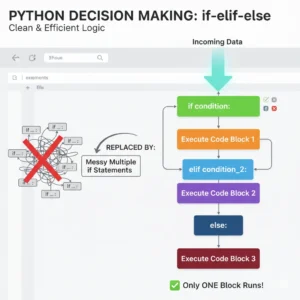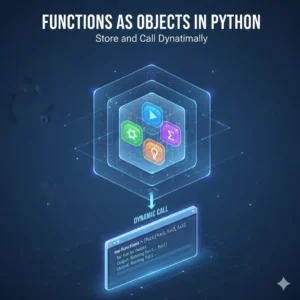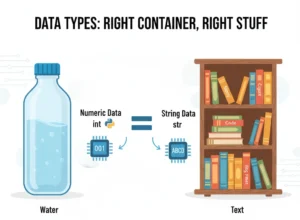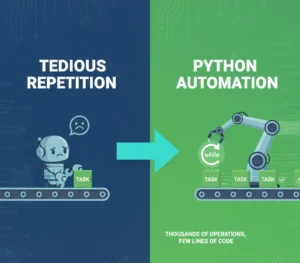Have you ever written a function in Python, only to find that the solution to your problem requires the same function again, just with slightly different data? This can feel like a programming paradox. How can you use a function before you’ve even finished writing it?
This elegant solution is called recursion, a fundamental concept that can simplify complex problems into clean, manageable code. While it sounds intimidating at first, it’s built on a simple idea: a function that calls itself.
In this guide, you’ll learn exactly what recursion is, how it works, and why it’s a powerful tool. We’ll break it down with a classic example—calculating a factorial—so you can walk away with a solid understanding and the confidence to start using recursion in your own projects.
What is Recursion in Python?
In Python, recursion occurs when a function calls itself during its execution. Instead of using a loop to repeat a task, a recursive function breaks the problem down into smaller, identical sub-problems.
Think of it like finding a word in a dictionary. You look up the word “programming,” and the definition contains the word “code.” You don’t understand “code,” so you look that up. The definition for “code” might reference “syntax,” leading you to look that up too. You are recursively using the “lookup” function until you reach a base understanding. Similarly, a recursive function keeps calling itself until it reaches a predefined stopping point.
The Two Essential Parts of a Recursive Function
Every recursive function must have two key components to work correctly and avoid running forever:
- Base Case: The condition that stops the recursion. It’s the simplest, smallest instance of the problem, which can be solved directly without another function call.
- Recursive Case: The part of the function where it calls itself with a modified argument, working towards the base case.
Understanding Recursion Through Factorials
The mathematical concept of a factorial is a perfect way to visualize recursion. The factorial of a number n (written as n!) is the product of all positive integers less than or equal to n.
For example:
5! = 5 * 4 * 3 * 2 * 1 = 1203! = 3 * 2 * 1 = 6
But there’s a recursive pattern here! Look closely:
5! = 5 * 4!4! = 4 * 3!3! = 3 * 2!
We can define the factorial function recursively as:
- Base Case:
factorial(1) = 1 - Recursive Case:
factorial(n) = n * factorial(n - 1)
Writing the Recursive Factorial Function in Python
Let’s translate this mathematical definition into Python code.
def factorial(n):
# Base Case: if n is 1, we can return the answer directly.
if n == 1:
return 1
# Recursive Case: otherwise, call the function again with n-1.
else:
return n * factorial(n - 1)
# Let's test it!
print(factorial(3)) # Output: 6
print(factorial(5)) # Output: 120This code works as follows:
- We call
factorial(3). - Since
3is not1, it goes to the recursive case:return 3 * factorial(2). - Now,
factorial(2)is called. It’s not1, so it returns2 * factorial(1). - Finally,
factorial(1)is called. This hits the base case and simply returns1. - The result now “unwinds”:
factorial(1)returns1tofactorial(2), which becomes2 * 1 = 2. This value2is returned tofactorial(3), which becomes3 * 2 = 6.
Visualizing the Call Stack
To truly understand, let’s trace the execution for factorial(3):
factorial(3)starts. It calculates3 * factorial(2)and waits.factorial(2)starts. It calculates2 * factorial(1)and waits.factorial(1)starts. It hits the base case and returns1.factorial(2)can now finish:2 * 1 = 2. It returns2.factorial(3)can now finish:3 * 2 = 6. It returns6, which is printed.
This “waiting” happens on a part of memory called the call stack. Each function call is stacked on top of the previous one. The base case is crucial because it provides the final answer that allows the entire stack to “unwind” and calculate the final result. Without it, the function would call itself infinitely until the program crashed.
Another Example: Summing a List Recursively
Let’s solidify our understanding with another simple example: summing a list of numbers.
def recursive_sum(numbers):
# Base Case: if the list is empty, the sum is 0.
if not numbers:
return 0
# Recursive Case: the sum is the first element + the sum of the rest of the list.
else:
return numbers[0] + recursive_sum(numbers[1:])
my_list = [1, 2, 3, 4]
print(recursive_sum(my_list)) # Output: 10Here, the base case is an empty list (sum of 0). The recursive case takes the first element and adds it to the sum of the remaining list (numbers[1:]), which is a smaller version of the original problem.
Ready to Go from Basics to Pro?
Understanding recursion is a major milestone, but it’s just one piece of the Python puzzle. To truly become proficient, you need a structured learning path that covers everything from core syntax to advanced concepts like object-oriented programming, web development, and data analysis.
Our comprehensive Python course is designed to take you from absolute beginner to job-ready developer. You’ll get expert guidance, work on real-world projects, and join a community of learners all focused on mastering Python.
If you’re serious about mastering Python, check out our pre-recorded python comprehensive video course.
Conclusion
Recursion is a powerful programming technique where a function solves a problem by calling itself on a smaller version of the problem. The two non-negotiable ingredients are a base case to stop the recursion and a recursive case to break the problem down. Starting with simple examples like factorials and list summation is the best way to build your intuition.
Like any skill, the key to mastering recursion is practice. Start with these examples, then challenge yourself with classic problems like calculating Fibonacci numbers or traversing file directories. Keep at it, and you’ll soon be thinking like a true programmer!
Common Questions About Recursion
When should I use recursion over a loop?
Recursion is best for problems that can naturally be divided into similar sub-problems, like traversing tree structures (e.g., file directories, organization charts). For simple, linear tasks, a loop is often more memory-efficient and straightforward.
Is recursion slower or faster than loops?
Recursion can be slower and use more memory due to the overhead of multiple function calls on the call stack. However, for certain problems, a well-designed recursive solution can be just as efficient and much more readable than a complex loop-based one.
What happens if I forget the base case?
If you forget the base case, the function will call itself indefinitely until it causes a “stack overflow” error, crashing your program. The base case is absolutely critical for a functioning recursive algorithm.















